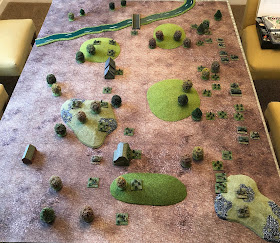For those not familiar with these rules, this is my 2017 review. It uses a square grid, which like To the Strongest! works well over Zoom. It is a grand tactical game typically played as a divisional or corps level game. The mechanisms are pretty straightforward, but the twist is the Operations Sheet, which gives a range of events and tactics that you pay for using dice. These events and tactics reflect the army you are using and you download a sheet for each one. For example, the Germans have tactics which emphasise flexibility and mobility, while the Russians have massed artillery.
For this game, I developed a scenario from my recent reading of Kaloyan Matev's, 'Red Wind Over the Balkans'. This book covers the Soviet offensive south of the Danube between September and October 1944.
The second phase of this campaign was the offensive over the Bulgarian border into Yugoslavia towards Belgrade. This was spearheaded by Soviet troops of the Third Ukrainian Front. The terrain in this part of Yugoslavia (modern Serbia) is mountainous, with limited road and rail communication. The Germans used their flexible battle-groups to hold the key positions and these included mountain trained troops, in this scenario a Prinz Eugen Division battlegroup. Soviet rifle divisions are not noted for their flexibility, but Matev shows how they managed to fight effectively in terrain they were certainly not trained to operate in.
Here is the setup, with the Germans defending the towns and mountain edges on the left as well as the bridge over the Danube. The Soviets coming in from the right. This is a historical game, so the Germans are heavily outnumbered.
The Russian steamroller moves forward, but the limited ops dice mean you have to marshall your resources. So I decided on a right hook to capture the bridge while bringing a rifle division and tanks up to the nearby town. By concentrating artillery, the Soviets blew away the German defenders, but it still took two moves.
Infantry attacks on the mountain positions were easily brushed away by the Germans, but a combined tank and infantry assault on the town was successful. Again it took more moves than I would have wished as the Germans were well-positioned, using the terrain effectively to block flanking attacks.
Switching the main effort to the left flank ran into trouble on the hills, but again a combined arms attack on the town was successful.
The German counterattack was beaten off and the Soviets poured down the valley. The Germans still held much of the high ground, but with their supply lines cut, it was time to make a tactical withdrawal.
As for Zoom suitability, the game is easily visualised. Both sides can use their Ops Sheet, although I tend to find that tactics cancel each other out and were not decisive. I have played this game without the Ops sheet, but you lose the subtlety of the different tactics.
It was a good game that gives a decent flavour of the historical campaign. I might try a tactical level game using Blitzkrieg Commander as a variant.




Looks a good game. As a coincidence the book you based the scenario on was delivered to me today....
ReplyDeleteCheers,
Pete.